Sociology Report: Media, Education, and Indigenous Australia
VerifiedAdded on 2023/01/19
|10
|2642
|77
Report
AI Summary
This sociology report examines the socio-cultural issue of early childhood education for Indigenous Australians, drawing on media sources (TV productions and newspapers) and academic literature. The report highlights the challenges of racism, discrimination, and historical assimilation policies that hinder Indigenous students' access to education. It reviews the literature, including the impact of orality and cultural values on educational outcomes. The report reflects on the knowledge gained about these issues, comparing media representations with academic findings. It emphasizes the importance of addressing educational inequality, promoting social inclusion, and providing adequate resources to support Indigenous students. The report also addresses research challenges and methodologies used to gather information. The conclusion emphasizes the need to eliminate education discrimination and improve educational outcomes for Indigenous children in Australia.
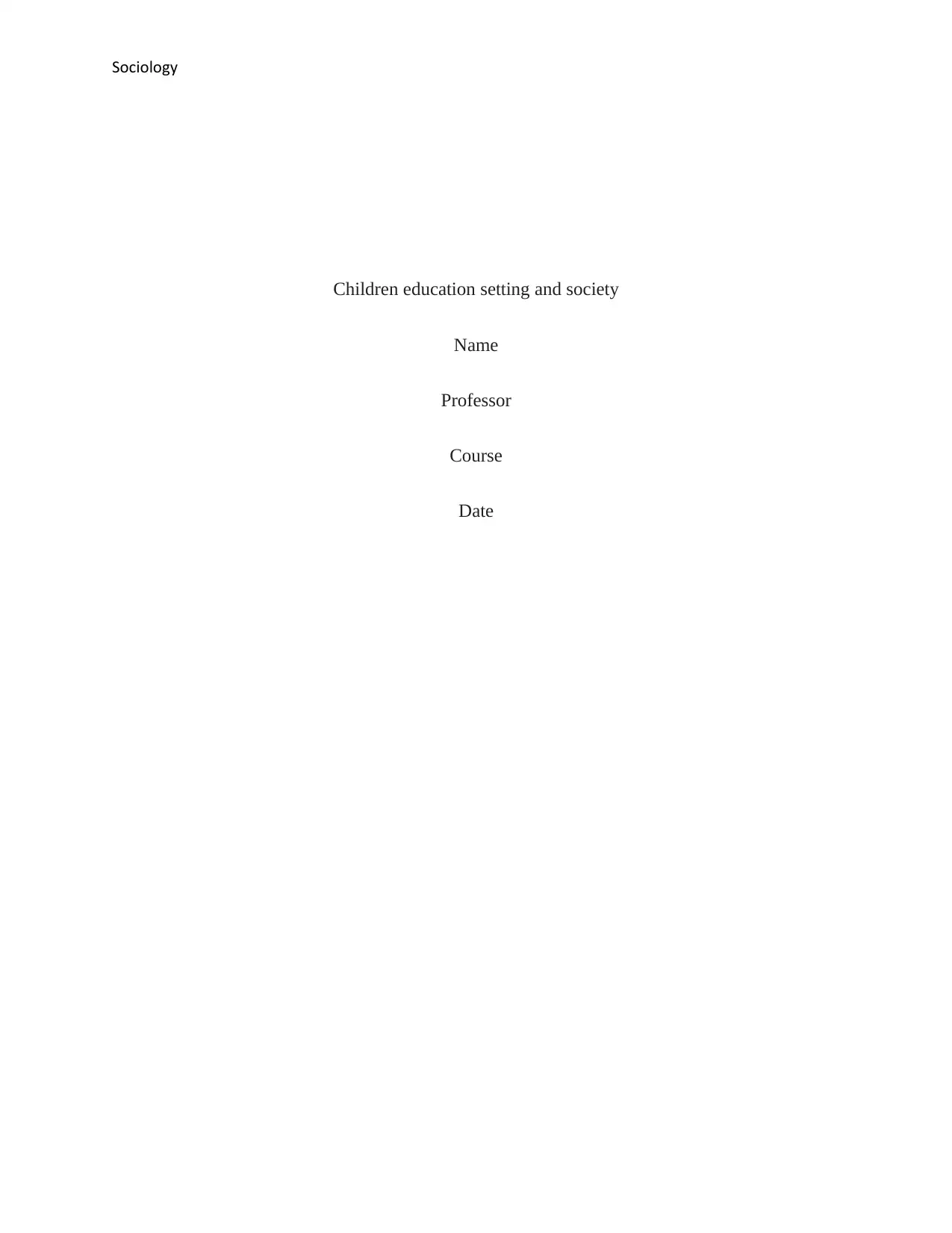
Sociology
Children education setting and society
Name
Professor
Course
Date
Children education setting and society
Name
Professor
Course
Date
Paraphrase This Document
Need a fresh take? Get an instant paraphrase of this document with our AI Paraphraser
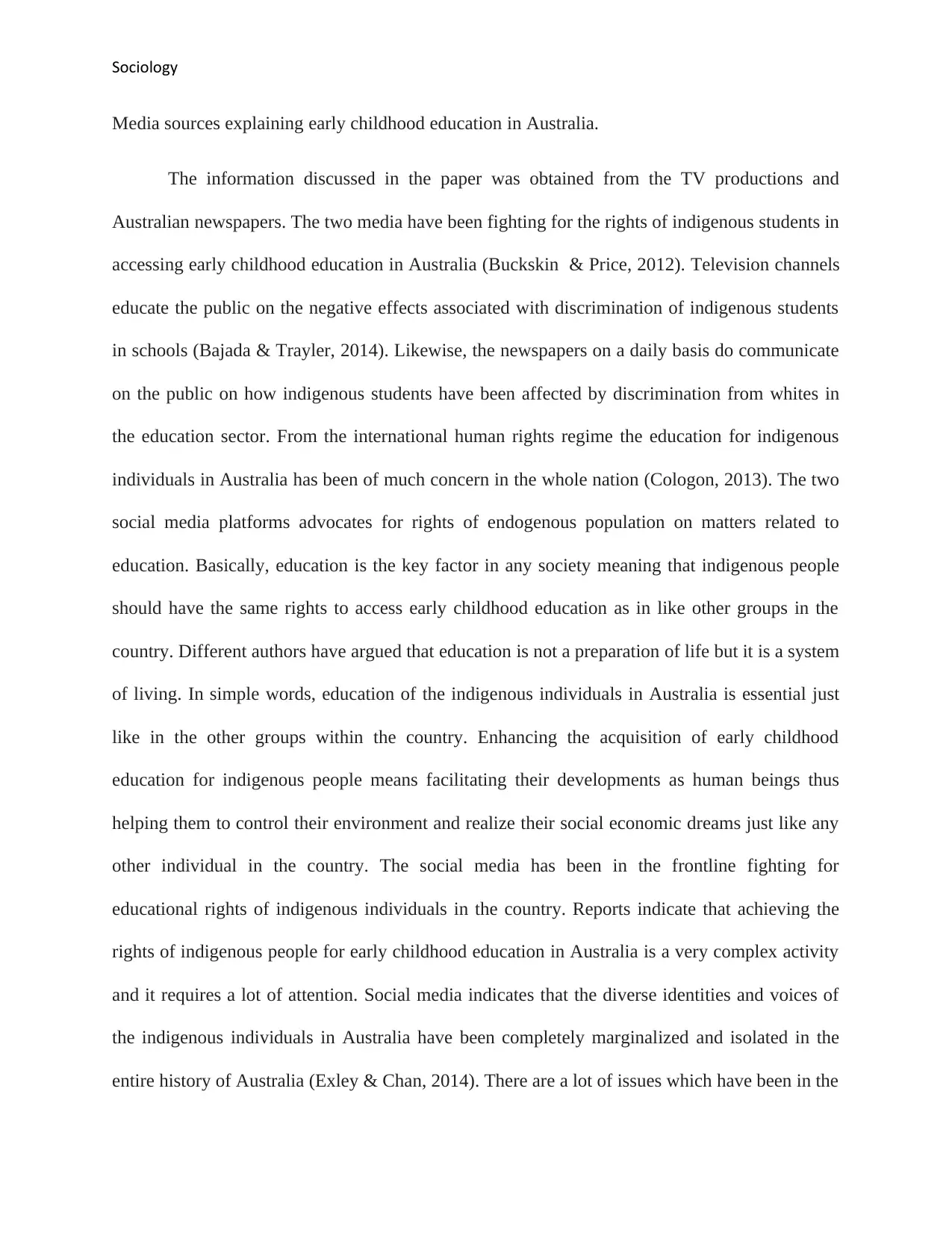
Sociology
Media sources explaining early childhood education in Australia.
The information discussed in the paper was obtained from the TV productions and
Australian newspapers. The two media have been fighting for the rights of indigenous students in
accessing early childhood education in Australia (Buckskin & Price, 2012). Television channels
educate the public on the negative effects associated with discrimination of indigenous students
in schools (Bajada & Trayler, 2014). Likewise, the newspapers on a daily basis do communicate
on the public on how indigenous students have been affected by discrimination from whites in
the education sector. From the international human rights regime the education for indigenous
individuals in Australia has been of much concern in the whole nation (Cologon, 2013). The two
social media platforms advocates for rights of endogenous population on matters related to
education. Basically, education is the key factor in any society meaning that indigenous people
should have the same rights to access early childhood education as in like other groups in the
country. Different authors have argued that education is not a preparation of life but it is a system
of living. In simple words, education of the indigenous individuals in Australia is essential just
like in the other groups within the country. Enhancing the acquisition of early childhood
education for indigenous people means facilitating their developments as human beings thus
helping them to control their environment and realize their social economic dreams just like any
other individual in the country. The social media has been in the frontline fighting for
educational rights of indigenous individuals in the country. Reports indicate that achieving the
rights of indigenous people for early childhood education in Australia is a very complex activity
and it requires a lot of attention. Social media indicates that the diverse identities and voices of
the indigenous individuals in Australia have been completely marginalized and isolated in the
entire history of Australia (Exley & Chan, 2014). There are a lot of issues which have been in the
Media sources explaining early childhood education in Australia.
The information discussed in the paper was obtained from the TV productions and
Australian newspapers. The two media have been fighting for the rights of indigenous students in
accessing early childhood education in Australia (Buckskin & Price, 2012). Television channels
educate the public on the negative effects associated with discrimination of indigenous students
in schools (Bajada & Trayler, 2014). Likewise, the newspapers on a daily basis do communicate
on the public on how indigenous students have been affected by discrimination from whites in
the education sector. From the international human rights regime the education for indigenous
individuals in Australia has been of much concern in the whole nation (Cologon, 2013). The two
social media platforms advocates for rights of endogenous population on matters related to
education. Basically, education is the key factor in any society meaning that indigenous people
should have the same rights to access early childhood education as in like other groups in the
country. Different authors have argued that education is not a preparation of life but it is a system
of living. In simple words, education of the indigenous individuals in Australia is essential just
like in the other groups within the country. Enhancing the acquisition of early childhood
education for indigenous people means facilitating their developments as human beings thus
helping them to control their environment and realize their social economic dreams just like any
other individual in the country. The social media has been in the frontline fighting for
educational rights of indigenous individuals in the country. Reports indicate that achieving the
rights of indigenous people for early childhood education in Australia is a very complex activity
and it requires a lot of attention. Social media indicates that the diverse identities and voices of
the indigenous individuals in Australia have been completely marginalized and isolated in the
entire history of Australia (Exley & Chan, 2014). There are a lot of issues which have been in the
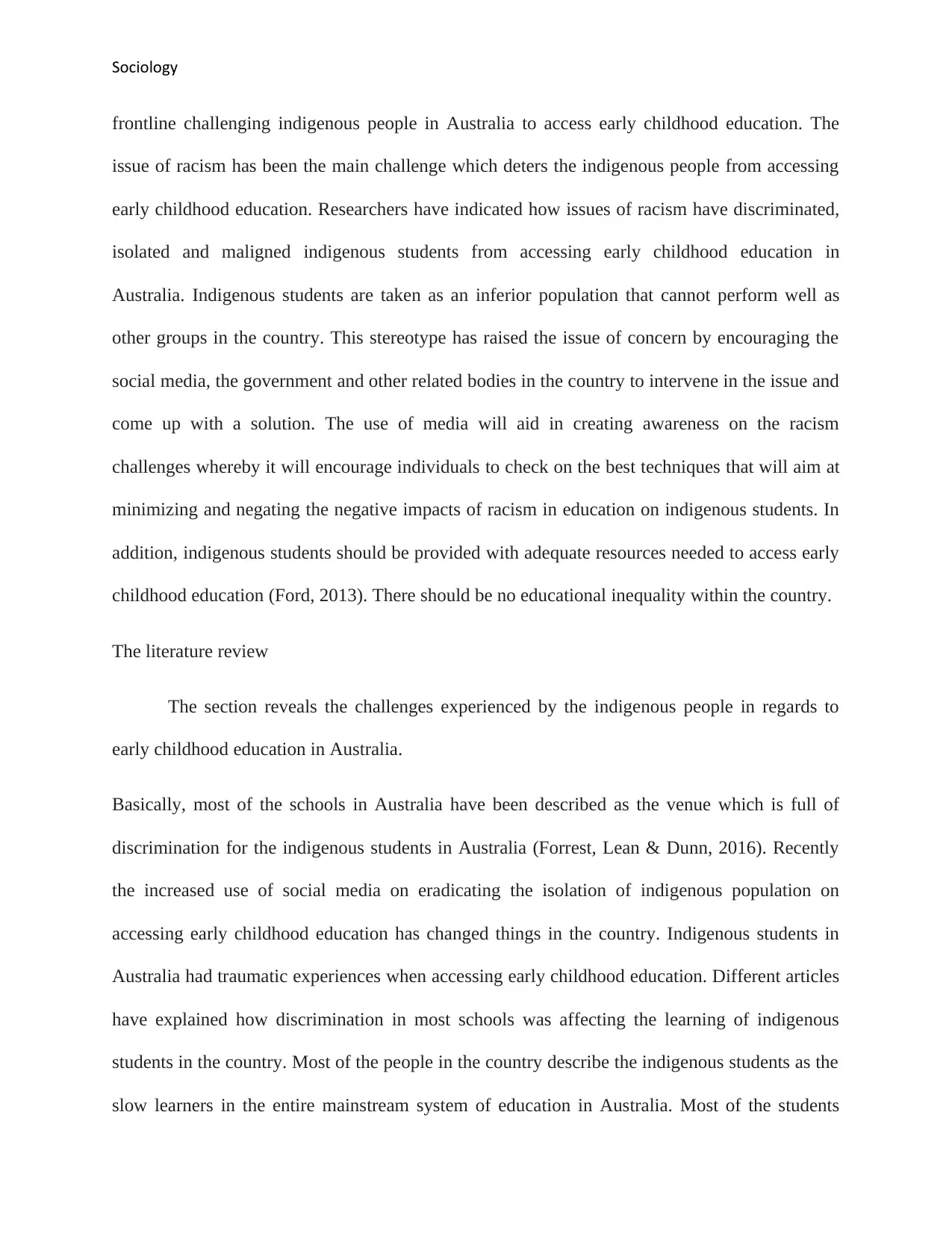
Sociology
frontline challenging indigenous people in Australia to access early childhood education. The
issue of racism has been the main challenge which deters the indigenous people from accessing
early childhood education. Researchers have indicated how issues of racism have discriminated,
isolated and maligned indigenous students from accessing early childhood education in
Australia. Indigenous students are taken as an inferior population that cannot perform well as
other groups in the country. This stereotype has raised the issue of concern by encouraging the
social media, the government and other related bodies in the country to intervene in the issue and
come up with a solution. The use of media will aid in creating awareness on the racism
challenges whereby it will encourage individuals to check on the best techniques that will aim at
minimizing and negating the negative impacts of racism in education on indigenous students. In
addition, indigenous students should be provided with adequate resources needed to access early
childhood education (Ford, 2013). There should be no educational inequality within the country.
The literature review
The section reveals the challenges experienced by the indigenous people in regards to
early childhood education in Australia.
Basically, most of the schools in Australia have been described as the venue which is full of
discrimination for the indigenous students in Australia (Forrest, Lean & Dunn, 2016). Recently
the increased use of social media on eradicating the isolation of indigenous population on
accessing early childhood education has changed things in the country. Indigenous students in
Australia had traumatic experiences when accessing early childhood education. Different articles
have explained how discrimination in most schools was affecting the learning of indigenous
students in the country. Most of the people in the country describe the indigenous students as the
slow learners in the entire mainstream system of education in Australia. Most of the students
frontline challenging indigenous people in Australia to access early childhood education. The
issue of racism has been the main challenge which deters the indigenous people from accessing
early childhood education. Researchers have indicated how issues of racism have discriminated,
isolated and maligned indigenous students from accessing early childhood education in
Australia. Indigenous students are taken as an inferior population that cannot perform well as
other groups in the country. This stereotype has raised the issue of concern by encouraging the
social media, the government and other related bodies in the country to intervene in the issue and
come up with a solution. The use of media will aid in creating awareness on the racism
challenges whereby it will encourage individuals to check on the best techniques that will aim at
minimizing and negating the negative impacts of racism in education on indigenous students. In
addition, indigenous students should be provided with adequate resources needed to access early
childhood education (Ford, 2013). There should be no educational inequality within the country.
The literature review
The section reveals the challenges experienced by the indigenous people in regards to
early childhood education in Australia.
Basically, most of the schools in Australia have been described as the venue which is full of
discrimination for the indigenous students in Australia (Forrest, Lean & Dunn, 2016). Recently
the increased use of social media on eradicating the isolation of indigenous population on
accessing early childhood education has changed things in the country. Indigenous students in
Australia had traumatic experiences when accessing early childhood education. Different articles
have explained how discrimination in most schools was affecting the learning of indigenous
students in the country. Most of the people in the country describe the indigenous students as the
slow learners in the entire mainstream system of education in Australia. Most of the students
⊘ This is a preview!⊘
Do you want full access?
Subscribe today to unlock all pages.

Trusted by 1+ million students worldwide
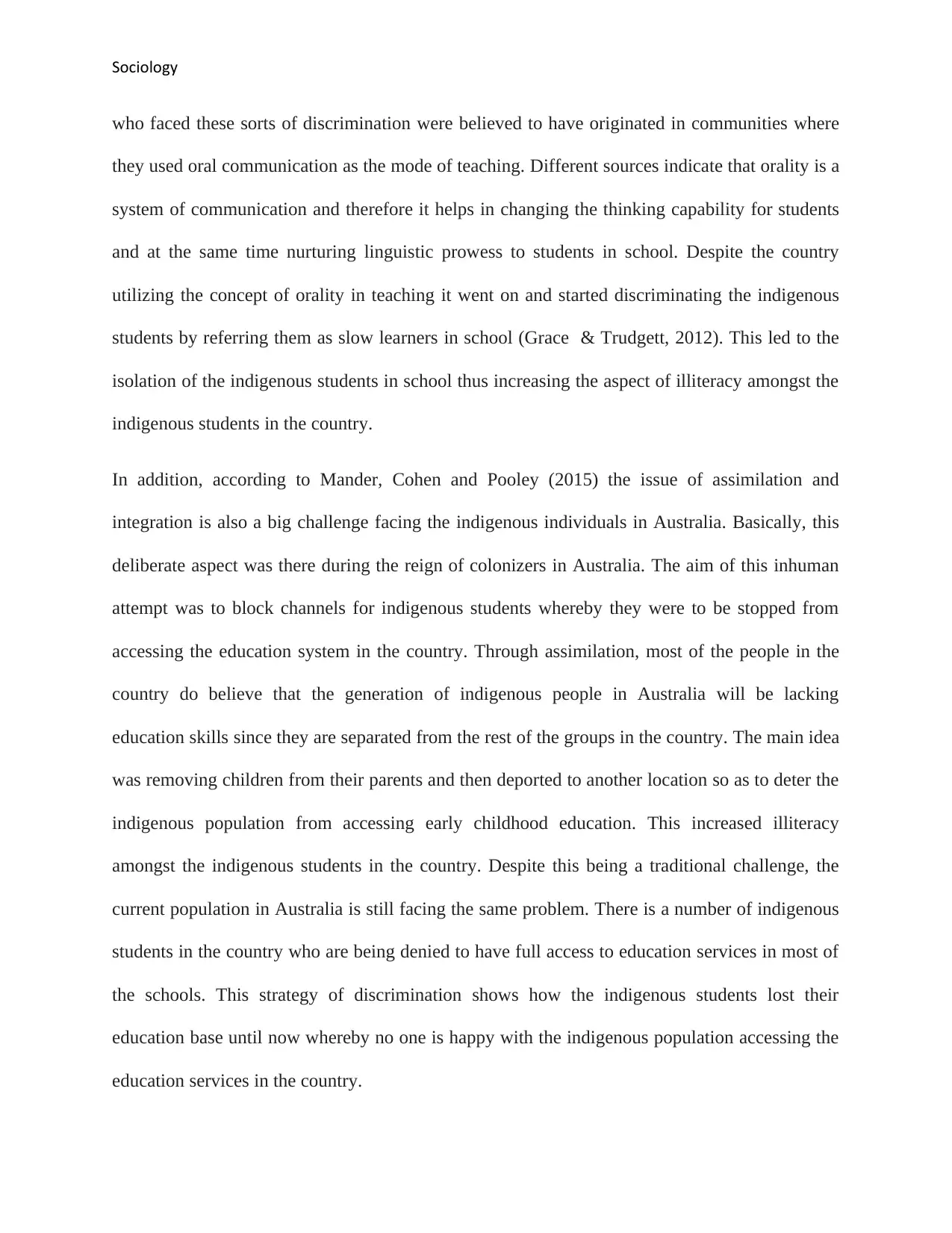
Sociology
who faced these sorts of discrimination were believed to have originated in communities where
they used oral communication as the mode of teaching. Different sources indicate that orality is a
system of communication and therefore it helps in changing the thinking capability for students
and at the same time nurturing linguistic prowess to students in school. Despite the country
utilizing the concept of orality in teaching it went on and started discriminating the indigenous
students by referring them as slow learners in school (Grace & Trudgett, 2012). This led to the
isolation of the indigenous students in school thus increasing the aspect of illiteracy amongst the
indigenous students in the country.
In addition, according to Mander, Cohen and Pooley (2015) the issue of assimilation and
integration is also a big challenge facing the indigenous individuals in Australia. Basically, this
deliberate aspect was there during the reign of colonizers in Australia. The aim of this inhuman
attempt was to block channels for indigenous students whereby they were to be stopped from
accessing the education system in the country. Through assimilation, most of the people in the
country do believe that the generation of indigenous people in Australia will be lacking
education skills since they are separated from the rest of the groups in the country. The main idea
was removing children from their parents and then deported to another location so as to deter the
indigenous population from accessing early childhood education. This increased illiteracy
amongst the indigenous students in the country. Despite this being a traditional challenge, the
current population in Australia is still facing the same problem. There is a number of indigenous
students in the country who are being denied to have full access to education services in most of
the schools. This strategy of discrimination shows how the indigenous students lost their
education base until now whereby no one is happy with the indigenous population accessing the
education services in the country.
who faced these sorts of discrimination were believed to have originated in communities where
they used oral communication as the mode of teaching. Different sources indicate that orality is a
system of communication and therefore it helps in changing the thinking capability for students
and at the same time nurturing linguistic prowess to students in school. Despite the country
utilizing the concept of orality in teaching it went on and started discriminating the indigenous
students by referring them as slow learners in school (Grace & Trudgett, 2012). This led to the
isolation of the indigenous students in school thus increasing the aspect of illiteracy amongst the
indigenous students in the country.
In addition, according to Mander, Cohen and Pooley (2015) the issue of assimilation and
integration is also a big challenge facing the indigenous individuals in Australia. Basically, this
deliberate aspect was there during the reign of colonizers in Australia. The aim of this inhuman
attempt was to block channels for indigenous students whereby they were to be stopped from
accessing the education system in the country. Through assimilation, most of the people in the
country do believe that the generation of indigenous people in Australia will be lacking
education skills since they are separated from the rest of the groups in the country. The main idea
was removing children from their parents and then deported to another location so as to deter the
indigenous population from accessing early childhood education. This increased illiteracy
amongst the indigenous students in the country. Despite this being a traditional challenge, the
current population in Australia is still facing the same problem. There is a number of indigenous
students in the country who are being denied to have full access to education services in most of
the schools. This strategy of discrimination shows how the indigenous students lost their
education base until now whereby no one is happy with the indigenous population accessing the
education services in the country.
Paraphrase This Document
Need a fresh take? Get an instant paraphrase of this document with our AI Paraphraser
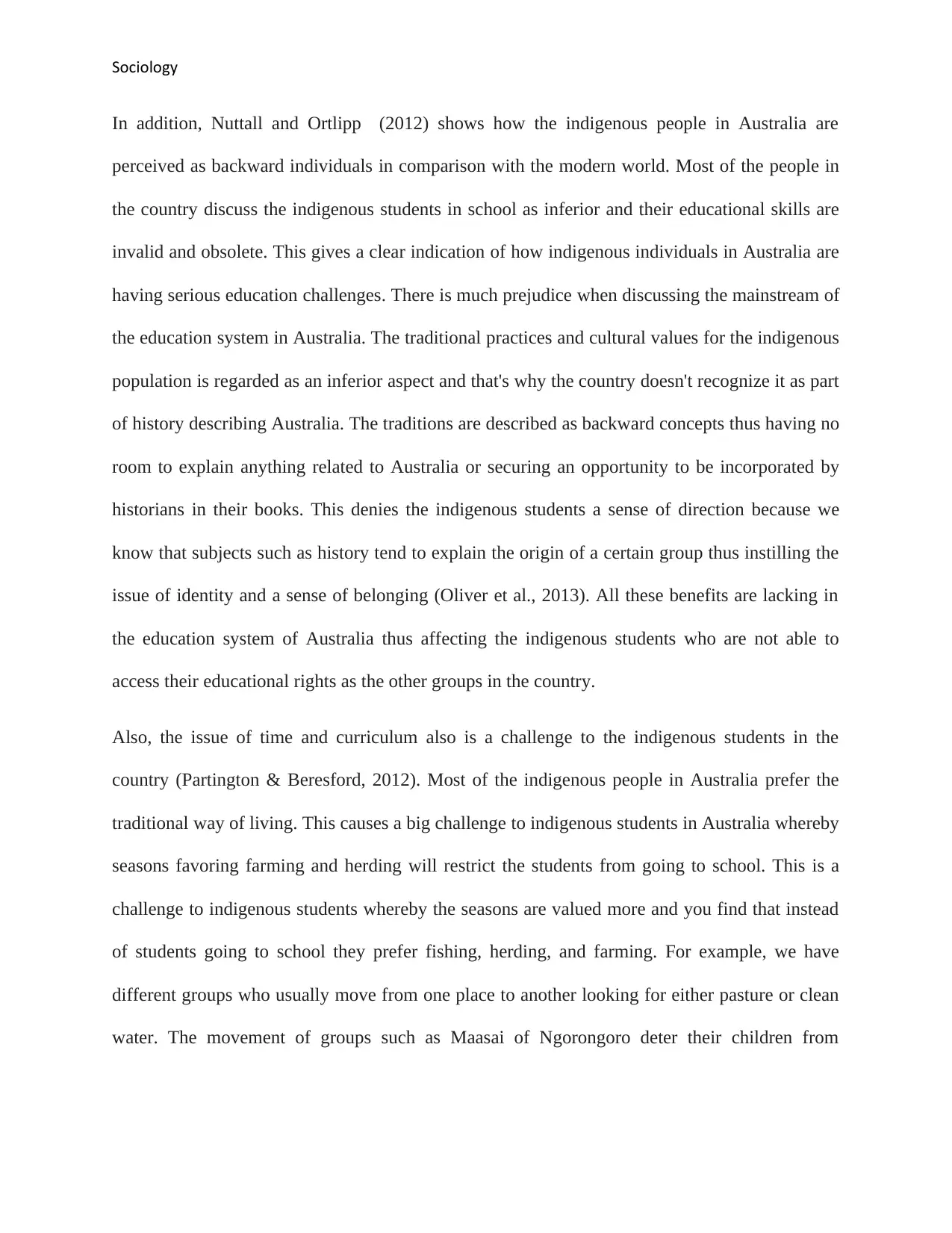
Sociology
In addition, Nuttall and Ortlipp (2012) shows how the indigenous people in Australia are
perceived as backward individuals in comparison with the modern world. Most of the people in
the country discuss the indigenous students in school as inferior and their educational skills are
invalid and obsolete. This gives a clear indication of how indigenous individuals in Australia are
having serious education challenges. There is much prejudice when discussing the mainstream of
the education system in Australia. The traditional practices and cultural values for the indigenous
population is regarded as an inferior aspect and that's why the country doesn't recognize it as part
of history describing Australia. The traditions are described as backward concepts thus having no
room to explain anything related to Australia or securing an opportunity to be incorporated by
historians in their books. This denies the indigenous students a sense of direction because we
know that subjects such as history tend to explain the origin of a certain group thus instilling the
issue of identity and a sense of belonging (Oliver et al., 2013). All these benefits are lacking in
the education system of Australia thus affecting the indigenous students who are not able to
access their educational rights as the other groups in the country.
Also, the issue of time and curriculum also is a challenge to the indigenous students in the
country (Partington & Beresford, 2012). Most of the indigenous people in Australia prefer the
traditional way of living. This causes a big challenge to indigenous students in Australia whereby
seasons favoring farming and herding will restrict the students from going to school. This is a
challenge to indigenous students whereby the seasons are valued more and you find that instead
of students going to school they prefer fishing, herding, and farming. For example, we have
different groups who usually move from one place to another looking for either pasture or clean
water. The movement of groups such as Maasai of Ngorongoro deter their children from
In addition, Nuttall and Ortlipp (2012) shows how the indigenous people in Australia are
perceived as backward individuals in comparison with the modern world. Most of the people in
the country discuss the indigenous students in school as inferior and their educational skills are
invalid and obsolete. This gives a clear indication of how indigenous individuals in Australia are
having serious education challenges. There is much prejudice when discussing the mainstream of
the education system in Australia. The traditional practices and cultural values for the indigenous
population is regarded as an inferior aspect and that's why the country doesn't recognize it as part
of history describing Australia. The traditions are described as backward concepts thus having no
room to explain anything related to Australia or securing an opportunity to be incorporated by
historians in their books. This denies the indigenous students a sense of direction because we
know that subjects such as history tend to explain the origin of a certain group thus instilling the
issue of identity and a sense of belonging (Oliver et al., 2013). All these benefits are lacking in
the education system of Australia thus affecting the indigenous students who are not able to
access their educational rights as the other groups in the country.
Also, the issue of time and curriculum also is a challenge to the indigenous students in the
country (Partington & Beresford, 2012). Most of the indigenous people in Australia prefer the
traditional way of living. This causes a big challenge to indigenous students in Australia whereby
seasons favoring farming and herding will restrict the students from going to school. This is a
challenge to indigenous students whereby the seasons are valued more and you find that instead
of students going to school they prefer fishing, herding, and farming. For example, we have
different groups who usually move from one place to another looking for either pasture or clean
water. The movement of groups such as Maasai of Ngorongoro deter their children from
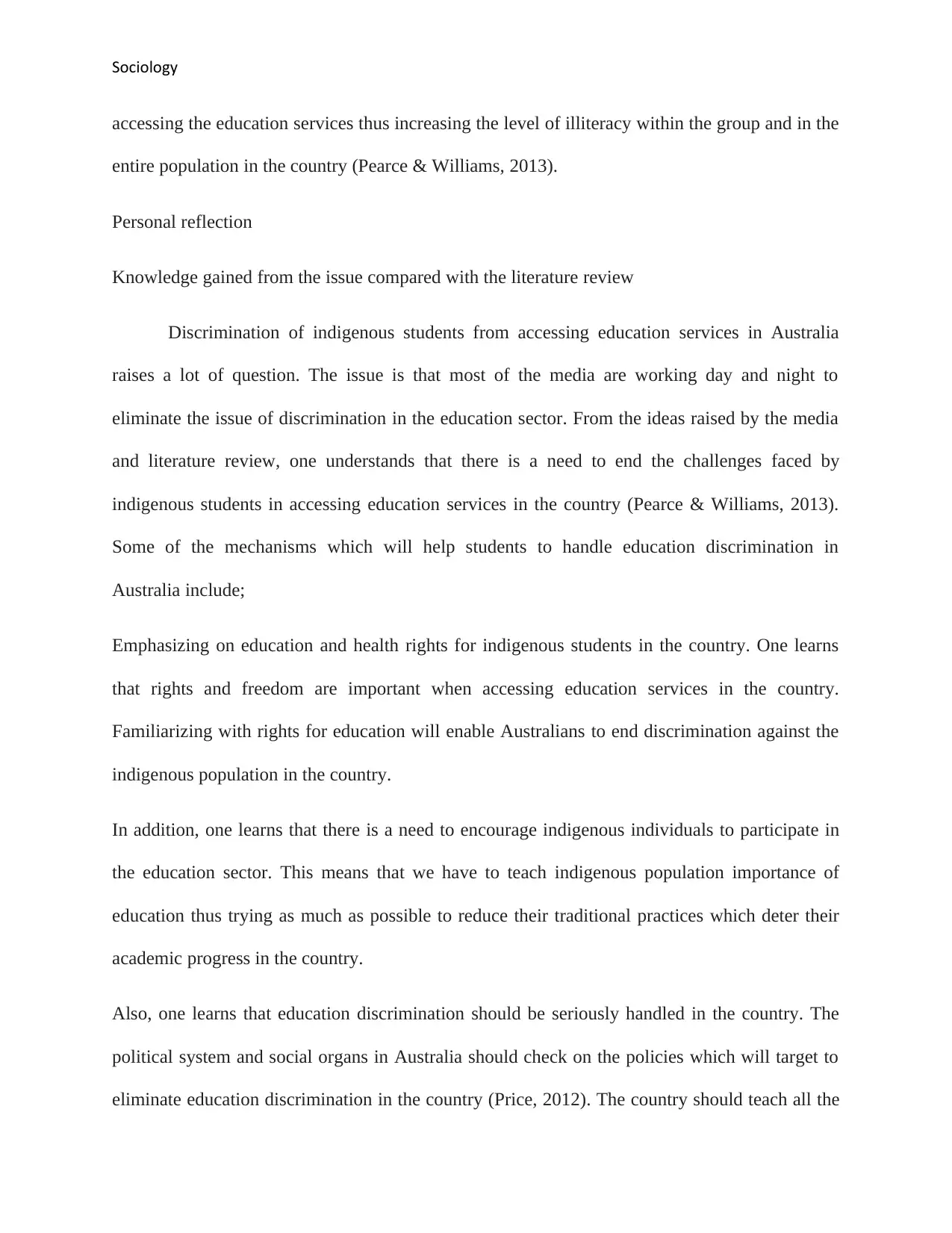
Sociology
accessing the education services thus increasing the level of illiteracy within the group and in the
entire population in the country (Pearce & Williams, 2013).
Personal reflection
Knowledge gained from the issue compared with the literature review
Discrimination of indigenous students from accessing education services in Australia
raises a lot of question. The issue is that most of the media are working day and night to
eliminate the issue of discrimination in the education sector. From the ideas raised by the media
and literature review, one understands that there is a need to end the challenges faced by
indigenous students in accessing education services in the country (Pearce & Williams, 2013).
Some of the mechanisms which will help students to handle education discrimination in
Australia include;
Emphasizing on education and health rights for indigenous students in the country. One learns
that rights and freedom are important when accessing education services in the country.
Familiarizing with rights for education will enable Australians to end discrimination against the
indigenous population in the country.
In addition, one learns that there is a need to encourage indigenous individuals to participate in
the education sector. This means that we have to teach indigenous population importance of
education thus trying as much as possible to reduce their traditional practices which deter their
academic progress in the country.
Also, one learns that education discrimination should be seriously handled in the country. The
political system and social organs in Australia should check on the policies which will target to
eliminate education discrimination in the country (Price, 2012). The country should teach all the
accessing the education services thus increasing the level of illiteracy within the group and in the
entire population in the country (Pearce & Williams, 2013).
Personal reflection
Knowledge gained from the issue compared with the literature review
Discrimination of indigenous students from accessing education services in Australia
raises a lot of question. The issue is that most of the media are working day and night to
eliminate the issue of discrimination in the education sector. From the ideas raised by the media
and literature review, one understands that there is a need to end the challenges faced by
indigenous students in accessing education services in the country (Pearce & Williams, 2013).
Some of the mechanisms which will help students to handle education discrimination in
Australia include;
Emphasizing on education and health rights for indigenous students in the country. One learns
that rights and freedom are important when accessing education services in the country.
Familiarizing with rights for education will enable Australians to end discrimination against the
indigenous population in the country.
In addition, one learns that there is a need to encourage indigenous individuals to participate in
the education sector. This means that we have to teach indigenous population importance of
education thus trying as much as possible to reduce their traditional practices which deter their
academic progress in the country.
Also, one learns that education discrimination should be seriously handled in the country. The
political system and social organs in Australia should check on the policies which will target to
eliminate education discrimination in the country (Price, 2012). The country should teach all the
⊘ This is a preview!⊘
Do you want full access?
Subscribe today to unlock all pages.

Trusted by 1+ million students worldwide
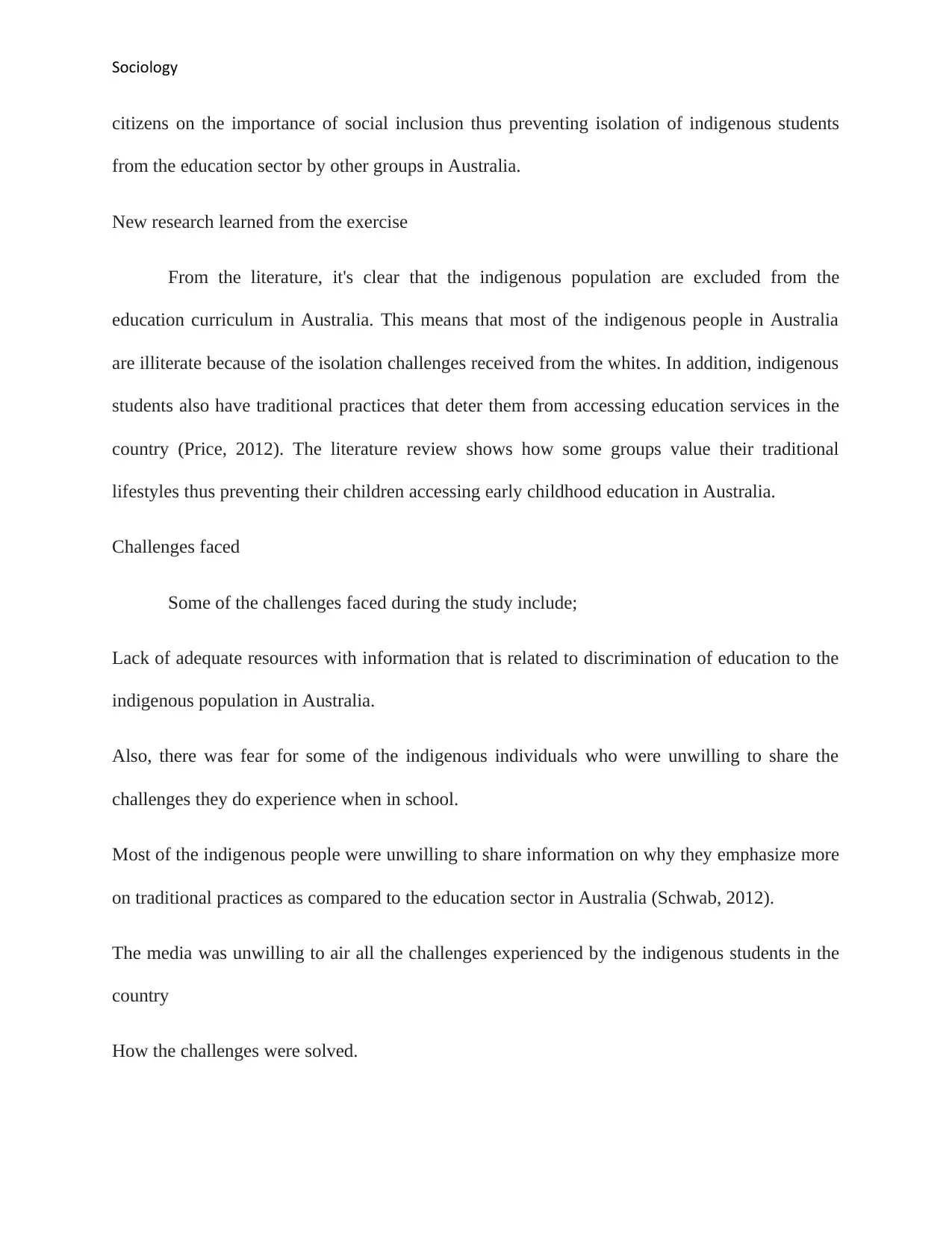
Sociology
citizens on the importance of social inclusion thus preventing isolation of indigenous students
from the education sector by other groups in Australia.
New research learned from the exercise
From the literature, it's clear that the indigenous population are excluded from the
education curriculum in Australia. This means that most of the indigenous people in Australia
are illiterate because of the isolation challenges received from the whites. In addition, indigenous
students also have traditional practices that deter them from accessing education services in the
country (Price, 2012). The literature review shows how some groups value their traditional
lifestyles thus preventing their children accessing early childhood education in Australia.
Challenges faced
Some of the challenges faced during the study include;
Lack of adequate resources with information that is related to discrimination of education to the
indigenous population in Australia.
Also, there was fear for some of the indigenous individuals who were unwilling to share the
challenges they do experience when in school.
Most of the indigenous people were unwilling to share information on why they emphasize more
on traditional practices as compared to the education sector in Australia (Schwab, 2012).
The media was unwilling to air all the challenges experienced by the indigenous students in the
country
How the challenges were solved.
citizens on the importance of social inclusion thus preventing isolation of indigenous students
from the education sector by other groups in Australia.
New research learned from the exercise
From the literature, it's clear that the indigenous population are excluded from the
education curriculum in Australia. This means that most of the indigenous people in Australia
are illiterate because of the isolation challenges received from the whites. In addition, indigenous
students also have traditional practices that deter them from accessing education services in the
country (Price, 2012). The literature review shows how some groups value their traditional
lifestyles thus preventing their children accessing early childhood education in Australia.
Challenges faced
Some of the challenges faced during the study include;
Lack of adequate resources with information that is related to discrimination of education to the
indigenous population in Australia.
Also, there was fear for some of the indigenous individuals who were unwilling to share the
challenges they do experience when in school.
Most of the indigenous people were unwilling to share information on why they emphasize more
on traditional practices as compared to the education sector in Australia (Schwab, 2012).
The media was unwilling to air all the challenges experienced by the indigenous students in the
country
How the challenges were solved.
Paraphrase This Document
Need a fresh take? Get an instant paraphrase of this document with our AI Paraphraser
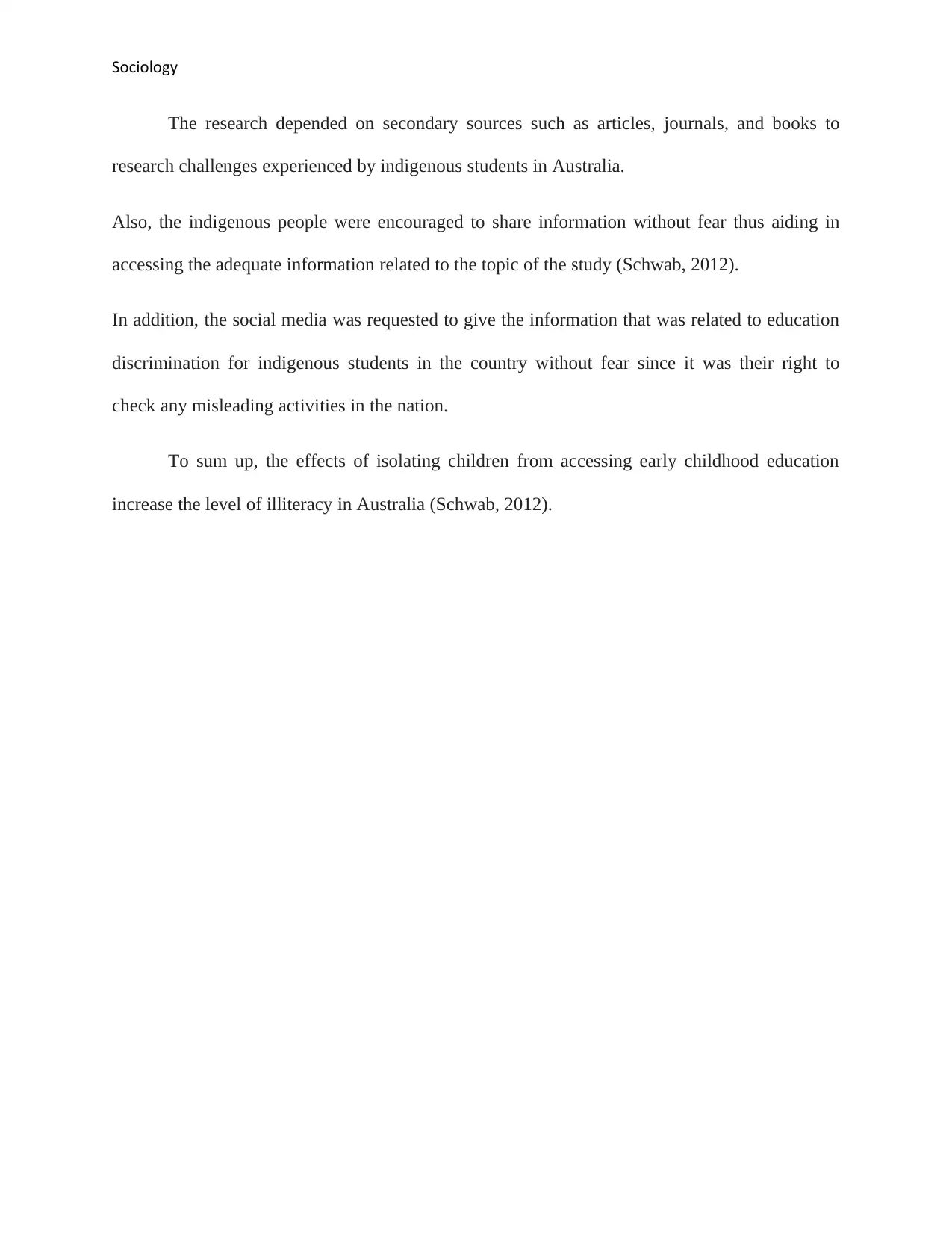
Sociology
The research depended on secondary sources such as articles, journals, and books to
research challenges experienced by indigenous students in Australia.
Also, the indigenous people were encouraged to share information without fear thus aiding in
accessing the adequate information related to the topic of the study (Schwab, 2012).
In addition, the social media was requested to give the information that was related to education
discrimination for indigenous students in the country without fear since it was their right to
check any misleading activities in the nation.
To sum up, the effects of isolating children from accessing early childhood education
increase the level of illiteracy in Australia (Schwab, 2012).
The research depended on secondary sources such as articles, journals, and books to
research challenges experienced by indigenous students in Australia.
Also, the indigenous people were encouraged to share information without fear thus aiding in
accessing the adequate information related to the topic of the study (Schwab, 2012).
In addition, the social media was requested to give the information that was related to education
discrimination for indigenous students in the country without fear since it was their right to
check any misleading activities in the nation.
To sum up, the effects of isolating children from accessing early childhood education
increase the level of illiteracy in Australia (Schwab, 2012).
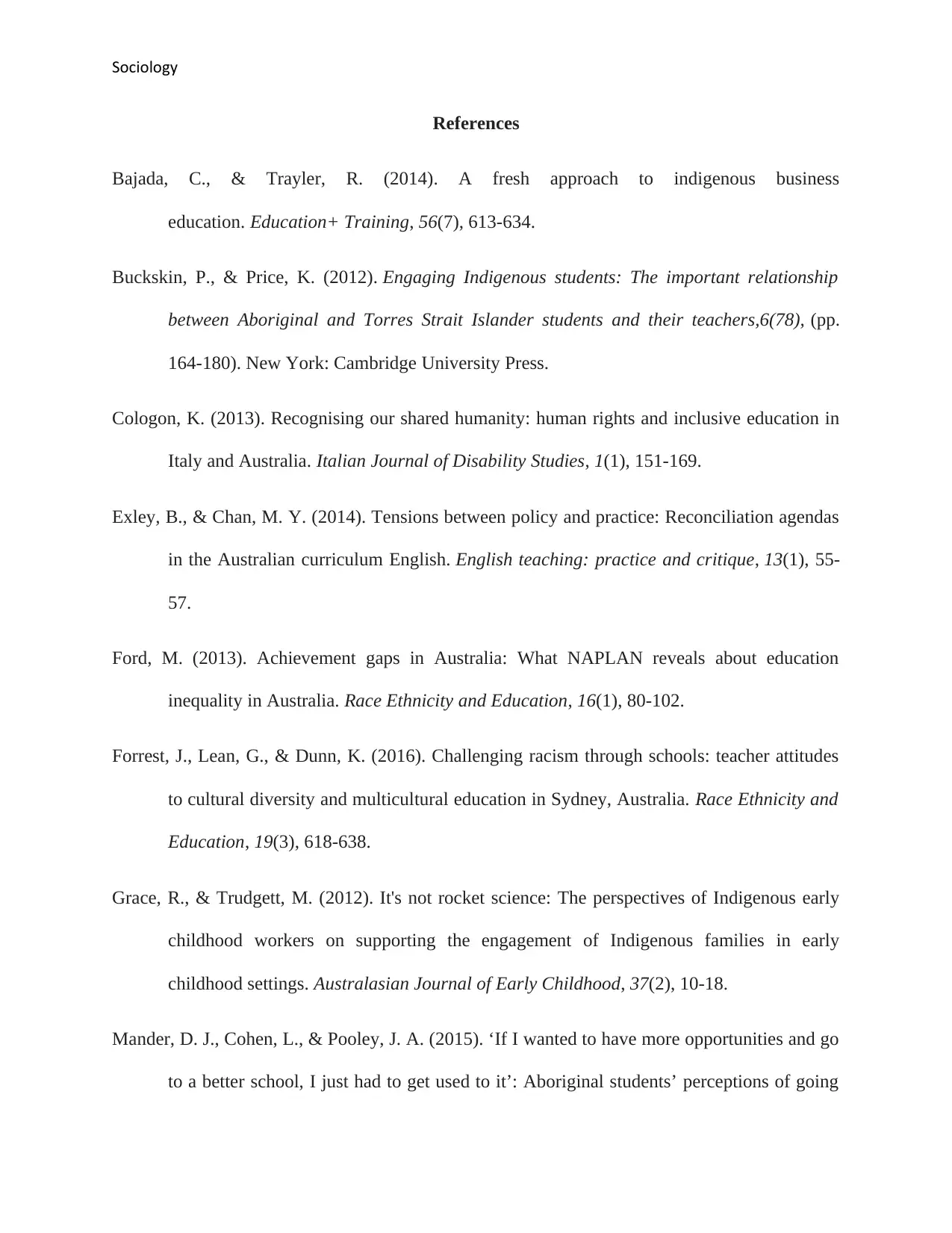
Sociology
References
Bajada, C., & Trayler, R. (2014). A fresh approach to indigenous business
education. Education+ Training, 56(7), 613-634.
Buckskin, P., & Price, K. (2012). Engaging Indigenous students: The important relationship
between Aboriginal and Torres Strait Islander students and their teachers,6(78), (pp.
164-180). New York: Cambridge University Press.
Cologon, K. (2013). Recognising our shared humanity: human rights and inclusive education in
Italy and Australia. Italian Journal of Disability Studies, 1(1), 151-169.
Exley, B., & Chan, M. Y. (2014). Tensions between policy and practice: Reconciliation agendas
in the Australian curriculum English. English teaching: practice and critique, 13(1), 55-
57.
Ford, M. (2013). Achievement gaps in Australia: What NAPLAN reveals about education
inequality in Australia. Race Ethnicity and Education, 16(1), 80-102.
Forrest, J., Lean, G., & Dunn, K. (2016). Challenging racism through schools: teacher attitudes
to cultural diversity and multicultural education in Sydney, Australia. Race Ethnicity and
Education, 19(3), 618-638.
Grace, R., & Trudgett, M. (2012). It's not rocket science: The perspectives of Indigenous early
childhood workers on supporting the engagement of Indigenous families in early
childhood settings. Australasian Journal of Early Childhood, 37(2), 10-18.
Mander, D. J., Cohen, L., & Pooley, J. A. (2015). ‘If I wanted to have more opportunities and go
to a better school, I just had to get used to it’: Aboriginal students’ perceptions of going
References
Bajada, C., & Trayler, R. (2014). A fresh approach to indigenous business
education. Education+ Training, 56(7), 613-634.
Buckskin, P., & Price, K. (2012). Engaging Indigenous students: The important relationship
between Aboriginal and Torres Strait Islander students and their teachers,6(78), (pp.
164-180). New York: Cambridge University Press.
Cologon, K. (2013). Recognising our shared humanity: human rights and inclusive education in
Italy and Australia. Italian Journal of Disability Studies, 1(1), 151-169.
Exley, B., & Chan, M. Y. (2014). Tensions between policy and practice: Reconciliation agendas
in the Australian curriculum English. English teaching: practice and critique, 13(1), 55-
57.
Ford, M. (2013). Achievement gaps in Australia: What NAPLAN reveals about education
inequality in Australia. Race Ethnicity and Education, 16(1), 80-102.
Forrest, J., Lean, G., & Dunn, K. (2016). Challenging racism through schools: teacher attitudes
to cultural diversity and multicultural education in Sydney, Australia. Race Ethnicity and
Education, 19(3), 618-638.
Grace, R., & Trudgett, M. (2012). It's not rocket science: The perspectives of Indigenous early
childhood workers on supporting the engagement of Indigenous families in early
childhood settings. Australasian Journal of Early Childhood, 37(2), 10-18.
Mander, D. J., Cohen, L., & Pooley, J. A. (2015). ‘If I wanted to have more opportunities and go
to a better school, I just had to get used to it’: Aboriginal students’ perceptions of going
⊘ This is a preview!⊘
Do you want full access?
Subscribe today to unlock all pages.

Trusted by 1+ million students worldwide
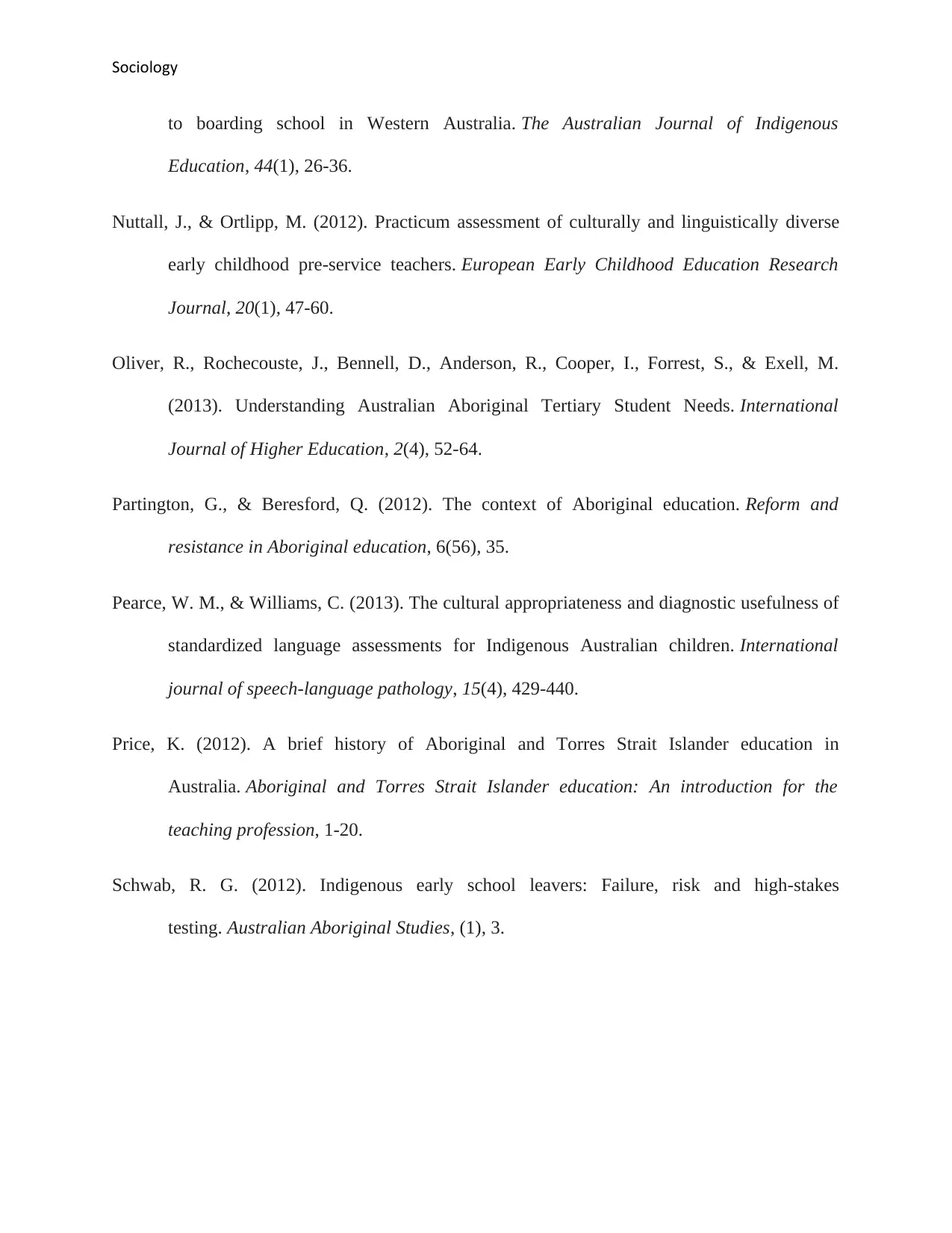
Sociology
to boarding school in Western Australia. The Australian Journal of Indigenous
Education, 44(1), 26-36.
Nuttall, J., & Ortlipp, M. (2012). Practicum assessment of culturally and linguistically diverse
early childhood pre-service teachers. European Early Childhood Education Research
Journal, 20(1), 47-60.
Oliver, R., Rochecouste, J., Bennell, D., Anderson, R., Cooper, I., Forrest, S., & Exell, M.
(2013). Understanding Australian Aboriginal Tertiary Student Needs. International
Journal of Higher Education, 2(4), 52-64.
Partington, G., & Beresford, Q. (2012). The context of Aboriginal education. Reform and
resistance in Aboriginal education, 6(56), 35.
Pearce, W. M., & Williams, C. (2013). The cultural appropriateness and diagnostic usefulness of
standardized language assessments for Indigenous Australian children. International
journal of speech-language pathology, 15(4), 429-440.
Price, K. (2012). A brief history of Aboriginal and Torres Strait Islander education in
Australia. Aboriginal and Torres Strait Islander education: An introduction for the
teaching profession, 1-20.
Schwab, R. G. (2012). Indigenous early school leavers: Failure, risk and high-stakes
testing. Australian Aboriginal Studies, (1), 3.
to boarding school in Western Australia. The Australian Journal of Indigenous
Education, 44(1), 26-36.
Nuttall, J., & Ortlipp, M. (2012). Practicum assessment of culturally and linguistically diverse
early childhood pre-service teachers. European Early Childhood Education Research
Journal, 20(1), 47-60.
Oliver, R., Rochecouste, J., Bennell, D., Anderson, R., Cooper, I., Forrest, S., & Exell, M.
(2013). Understanding Australian Aboriginal Tertiary Student Needs. International
Journal of Higher Education, 2(4), 52-64.
Partington, G., & Beresford, Q. (2012). The context of Aboriginal education. Reform and
resistance in Aboriginal education, 6(56), 35.
Pearce, W. M., & Williams, C. (2013). The cultural appropriateness and diagnostic usefulness of
standardized language assessments for Indigenous Australian children. International
journal of speech-language pathology, 15(4), 429-440.
Price, K. (2012). A brief history of Aboriginal and Torres Strait Islander education in
Australia. Aboriginal and Torres Strait Islander education: An introduction for the
teaching profession, 1-20.
Schwab, R. G. (2012). Indigenous early school leavers: Failure, risk and high-stakes
testing. Australian Aboriginal Studies, (1), 3.
1 out of 10
Related Documents
Your All-in-One AI-Powered Toolkit for Academic Success.
+13062052269
info@desklib.com
Available 24*7 on WhatsApp / Email
![[object Object]](/_next/static/media/star-bottom.7253800d.svg)
Unlock your academic potential
Copyright © 2020–2025 A2Z Services. All Rights Reserved. Developed and managed by ZUCOL.





